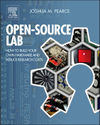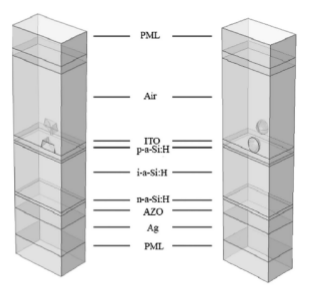Enhancement of hydrogenated amorphous silicon solar cells with front-surface hexagonal plasmonic arrays from nanoscale lithography

|
By Michigan Tech's Open Sustainability Technology Lab.
Wanted: Students to make a distributed future with solar-powered open-source RepRap 3-D printing and recyclebot recycling. |

|
Contents
Source
- Chenlong Zhang, Jephias Gwamuri, Sandra Cvetanovic, Mehdi Sadatgol, Durdu O Guney and Joshua M Pearce Enhancement of hydrogenated amorphous silicon solar cells with front-surface hexagonal plasmonic arrays from nanoscale lithography. Journal of Optics, 19, 075901 (2017) https://doi.org/10.1088/2040-8986/aa7291 open access
Abstract
The study first uses numerical simulations of hexagonal triangle and sphere arrays to optimize the performance of hydrogenated amorphous silicon (a-Si:H) photovoltaic devices. The simulations indicated the potential for a sphere array to provide optical enhancement (OE) up to 7.4% compared to a standard cell using a nanosphere radius of 250 nm and silver film thickness of 50 nm. Next a detailed series of a-Si:H cells were fabricated and tested for quantum efficiency and characteristic and current–voltage (I–V) profiles using a solar simulator. Triangle and sphere array based cells, as well as the uncoated reference cells are analyzed and the results find that the simulation does not precisely predict the observed enhancement, but it forecasts a trend and can be used to guide fabrication. In general, the measured OE follows the simulated trend: (1) for triangular arrays no enhancement is observed and as the silver thickness increases the more degradation of the cell; (2) for annealed arrays both measured and simulated OE occur with the thinner silver thickness. Measured efficiency enhancement reached 20.2% and 10.9% for nanosphere diameter D = 500 nm, silver thicknesses h = 50 nm and 25 nm, respectively. These values, which surpass simulation results, indicate that this method is worth additional investigation.
Keywords
Absorption ; Metamaterials ; Solar cells ; Semiconductors ; Skin ; Absorbance ; Metals ; Engineering ; Light emitting diodes ; Optoelectronic devices; amorphous silicon; plasmonics; hexagonal array; nanosphere lithography; scattering; photovoltaic
See Also
- Advances in plasmonic light trapping in thin-film solar photovoltaic devices
- Plasmonic Perfect Meta-Absobers for a-Si PV Devices
- Limitations of ultra-thin transparent conducting oxides for integration into plasmonic-enhanced thin-film solar photovoltaic devices
- Optical modelling of thin film microstructures literature review
- Multi-resonant silver nano-disk patterned thin film hydrogenated amorphous silicon solar cells for Staebler-Wronski effect compensation
- Influence of Oxygen Concentration on the Performance of Ultra-Thin RF Magnetron Sputter Deposited Indium Tin Oxide Films as a Top Electrode for Photovoltaic Devices
- A new method of preparing highly conductive ultra-thin indium tin oxide for plasmonic-enhanced thin film solar photovoltaic devices
- Plasmonic enhancement of amorphous silicon solar photovoltaic cells with hexagonal silver arrays made with nanosphere lithography
- Fabricating Ordered 2-D Nano-Structured Arrays Using Nanosphere Lithography
- Ambiance-dependent Agglomeration and Surface-enhanced Raman Spectroscopy Response of Self-assembled Silver Nano-particles for Plasmonic Photovoltaic Devices
- Optimal Design of Thin-film Plasmonic Solar Cells using Differential Evolution Optimization Algorithms
- Scalable honeycomb top contact to increase the light absorption and reduce the series resistance of thin film solar cells
